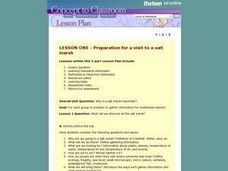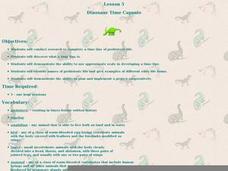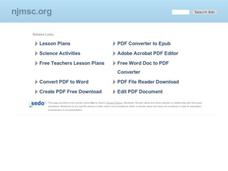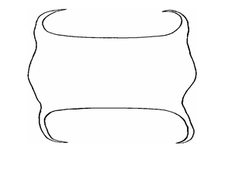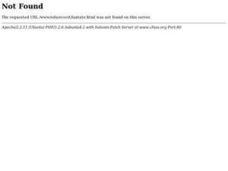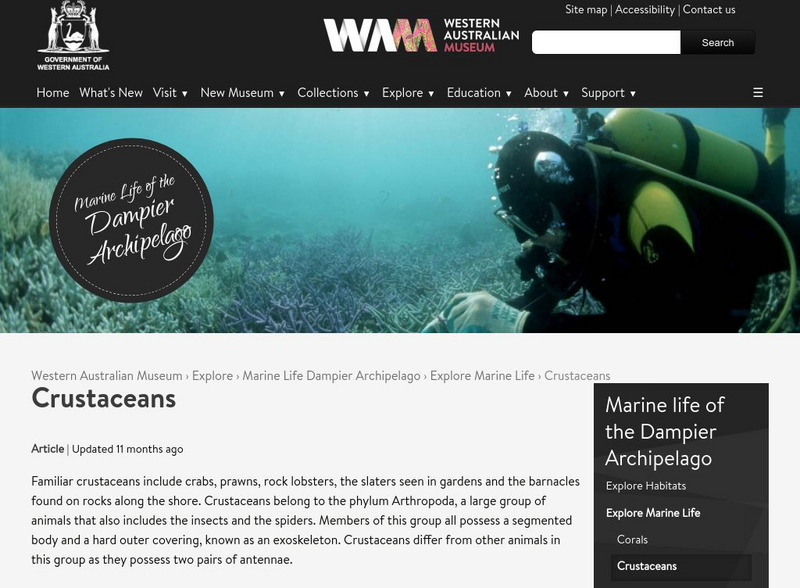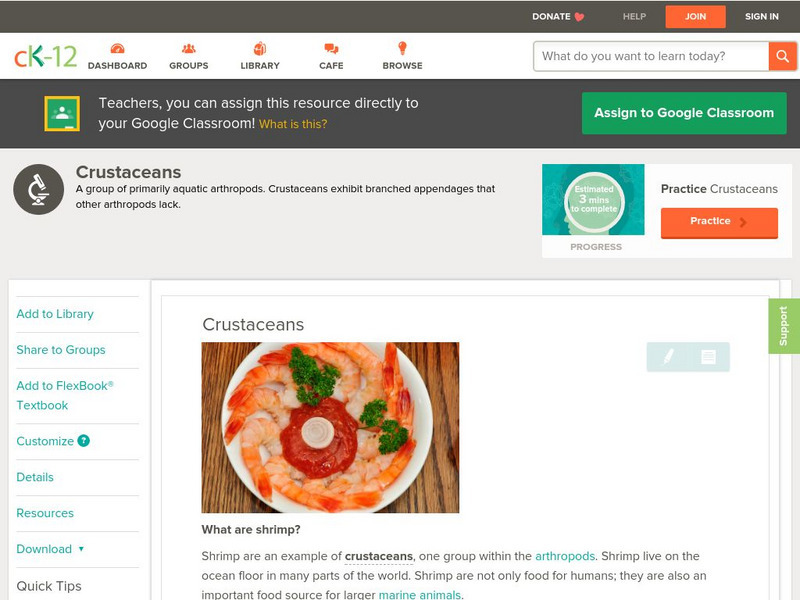Curated OER
Why is a salt marsh important?
Middle schoolers discuss the salt marsh. They define the following terms: habitat, water, land and air. Students work in small groups. They are asked why are they going to a salt marsh? Middle schoolers discuss whose habitat is it at...
Curated OER
Invertebrate Vocabulary-- Marine Invertebrate Match
In this science worksheet, young scholars study 12 vocabulary words which pertain to marine invertebrates. Students read the definitions which include pronunciation, part of speech and meaning of the name. Young scholars then look at 16...
Curated OER
Create An Insect
Students create a new species of insect. They create a list of insect characteristics and use this as a springboard to draw an insect of their own. Students write a brief descriptive paragraphs about their insect, giving particular...
Curated OER
A Science Experiment With Crayfish
A crayfish can lead to a science experiment involving habitats, animal behavior, and anatomy..
Curated OER
Pond Ecosystem Field Trip
Students investigate the environment by participating in a class trip. In this pond ecosystem lesson, students define a list of vocabulary terms associated with ponds such as invertebrate and metamorphosis. Students attend a field trip...
Curated OER
Endangered Species
In this endangered species worksheet, students complete math word problems where they refer to the chart about endangered species. Students complete 7 problems.
Curated OER
Dinosaur Time Capsule
Third graders research prehistoric life using educational software. They design a prehistoric life while showing the use of appropriate scale and names for the prehistoric life. They follow an internet link to participate in a virtual...
Curated OER
Ecosystem Damage from Household Cleaners
Third graders assess the damage done to various ecosystems by cleaning products and discover how scientists test water quality. Using stream water and common household cleaning agents, they work in groups to test for pH levels. Once...
Curated OER
Invertebrates
In this invertebrates worksheet, students read about the characteristics of the different groups of invertebrates. Then students complete 10 multiple choice questions.
Curated OER
Stream Watch
Students discuss why it is important to take care of streams, what is non-point source and point source pollution, what are some causes of pollution in streams, and what can we do to prevent some of these causes of pollution? They steam...
Curated OER
Comparing and Contrasting
Students practice compare and contrast skills. In this science and language development lesson, students complete a T chart generating traits of a snail and a clam. Students complete a related worksheet.
Curated OER
Brine Shrimp Life Cycle
Second graders investigate the life cycle of the brine shrimp. They use a variety of resources to find the details of each step. Students compare the life cycles of different organisms. They create diagrams of the different stages while...
Curated OER
Skates
Students gain understanding of structure, characteristics, and basic needs of living things and their role in world, identify parts of skate, observe details of skate's body and skate egg case, and identify unique characteristics of skates.
Curated OER
Build A "Bug"
Students brainstorm different adaptations that bug would need to live in aquatic environment, and watch presentation where classmate is dressed up in costume to represent adaptations necessary for macroinvertebrate to survive in water.
Curated OER
Stream Habitats and Biota
Young scholars identify native and introduced species of fish, shellfish and insects that inhabit Hawaii's streams. They use this information to predict the impact of stream restoration projects in Hawaii.
Curated OER
Amphipod Ecology
Students count amphipods under kelp wracks of varying ages to explain how long it takes for them to find their food source. They collect and represent the data.
Curated OER
Land Use
Learners examine ecosystems that covered Illinois 200 years ago, investigate some living and non-living components of ecosystems, identify components of prairie system, create food webs, and observe human effects on environment. Lessons...
Curated OER
Hatching Brine shrimp
Second graders investigate the life cycle using brine shrimp as an example. They conduct observations by watching the shrimp hatch out of cysts. Students design simple experiment to structure an observation. The experiment is approved...
Curated OER
Antarctica Food Chain
Students visit an interactive web page. In this food chain lesson, students visit an interactive web page displaying an example of the food chain in Antarctica. As students move their mouse over the images, captions appear describing the...
Curated OER
The First Thanksgiving: Crossword
In this Thanksgiving worksheet, students use a set of 11 clues about Thanksgiving to complete a crossword puzzle; answers are given on page 2.
Unite for Literacy
Unite for Literacy: Animals: Roly Poly
Read facts about the amazing pillbug and how this crustacean helps humans. Includes audio narration in 6 additional languages with text in English.
Other
Western Australian Museum: Crustaceans: Marine Life of the Dampier Archipelago
Do you know how Crustaceans differ from other animals that belong to the Arthropod family? Find the answer to this question along with other interesting facts about this marine animal.
CK-12 Foundation
Ck 12: Life Science: Crustaceans
[Free Registration/Login may be required to access all resource tools.] Crustaceans are a large group of arthropods, consisting of almost 52,000 species. The majority of crustaceans are aquatic. A few groups have adapted to living on...
